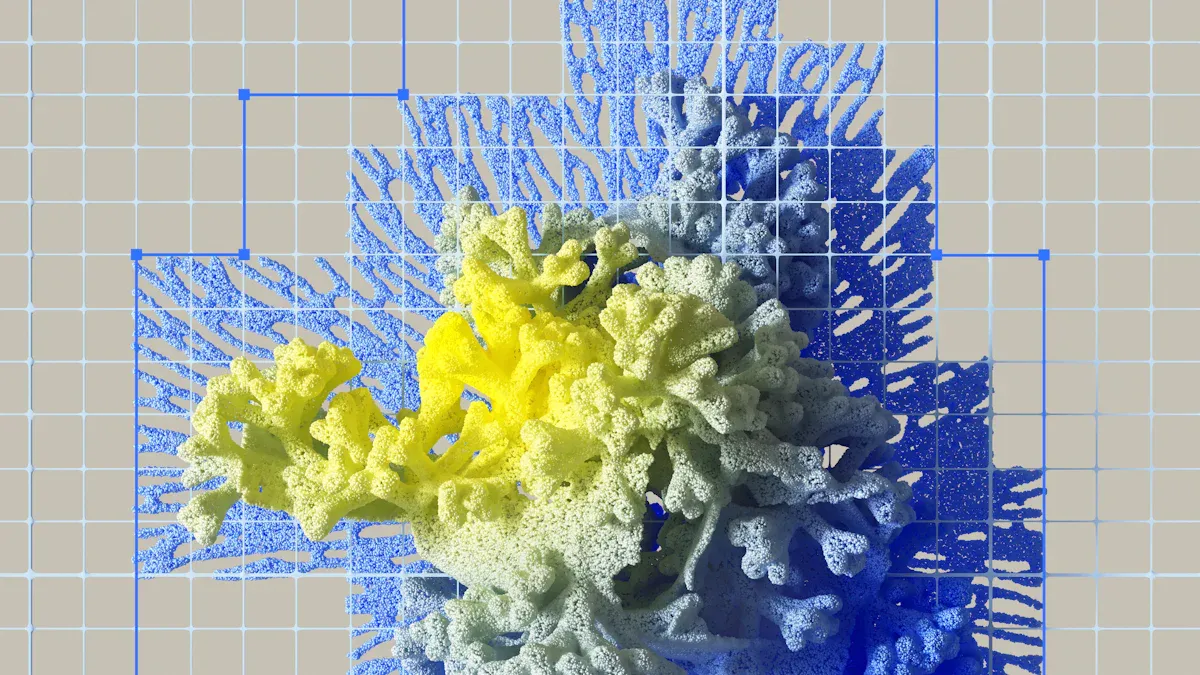
In 2025, activewear becomes an intelligent system, not just simple fabrics. AI acts as the brain behind these new textiles. It analyzes huge datasets on the human body, material science, and weather conditions. This analysis powers the design of smart, responsive fabrics. Imagine a shirt that senses your sweat. It opens its weave to cool you down. It then tightens to keep you warm. This is the new reality AI for designing is building today. AI-driven textile systems are making this possible.
Note: Today's smart activewear already uses intelligent sensing.
- Nadi X yoga pants use vibrations to help with poses.
- STATSports Apex trackers monitor an athlete's speed and distance.
- Incus Nova wearables analyze a swimmer's stroke.
These innovations show how smart textiles are changing sports.
The Process of AI for Designing Adaptive Textiles

The creation of adaptive textiles is a complex process. AI for designing simplifies this journey from concept to final product. It uses data to build better, smarter fabrics. This AI-guided design process involves several key stages. Each stage uses technology to improve performance and personalization.
Generative Design for Smart Textiles
Generative design uses AI algorithms to invent new fiber structures. These algorithms explore thousands of design possibilities. They create innovative fabric weaves that humans might not imagine. The AI-guided design process focuses on specific goals, like heat retention or cooling. It simulates how different technical textiles will perform under various conditions. This allows designers to test fabrics digitally before making them.
The software prioritizes material efficiency and performance. It achieves this through shape optimization and smart material placement. This method creates stable technical textiles with minimal waste. The result is a new generation of smart textiles. These textiles have complex, adaptive forms that respond to environmental factors.
Several companies are already pioneering this technology. They use AI to generate unique patterns and technical textiles for fashion and other industries.
- Unmade uses generative design for customizable knitwear patterns.
- PatternedAI creates seamless, customizable patterns for fashion and home decor.
- SXD AI develops scalable textile patterns, reducing waste and saving time.
- FabricGenie allows users to generate unique fabric patterns using specific design inputs.
AI-Driven Material Selection
Choosing the right materials is critical for performance activewear. AI analyzes vast databases of material properties. It recommends the best mix of natural and synthetic materials for specific goals. An AI system can identify the perfect blend for moisture-wicking fabrics or insulating technical textiles.
Automated blending machinery then uses this information. These systems blend different fibers in precise amounts to ensure uniform quality. This technological progress enhances the blending process. It leads to reduced material waste and the production of high-quality smart fabrics. The AI can assess fiber characteristics. It predicts their suitability for market needs, ensuring the final materials meet consumer expectations.
Personalization via AI and Wearables
One-size-fits-all activewear is becoming a thing of the past. AI for designing enables deep personalization. It processes 3D body scans to create a perfect, custom fit. It also uses biometric data from wearables to tailor clothing to an individual's unique physiology. This creates smart apparel that truly works for the user.
Companies like Hexoskin and OMsignal develop garments that collect deep biometric data. This includes heart rate, respiration, and muscle activity. AI then generates personalized insights from this data. For example, a smart shirt can modify fitness recommendations based on breathing patterns. Thermoregulating jackets can dynamically respond to changes in body heat.
Under Armour's smart apparel shows the potential of this technology. Its connected clothing uses embedded sensors to monitor muscle activity and fatigue. This real-time data helps athletes optimize training and prevent injuries. The insights from the wearable data customize training programs and improve performance metrics like speed and endurance. This is how smart textiles and wearables work together to create a truly personal experience.
The Future of Intelligent Activewear

The evolution of activewear points toward a future where clothing becomes a dynamic partner in our daily lives. Current smart apparel collects data. Future intelligent activewear will use that data to act, creating multifunctional textile systems that anticipate and respond to our needs in real time. This leap forward is driven by advancements in AI-embedded textiles, sustainable materials, and predictive analytics.
Real-Time Adaptive Clothing
The next frontier is clothing that physically changes its properties without user input. This involves responsive textiles with embedded technologies controlled by an onboard AI. These smart fabrics will automatically adjust fit, structure, and temperature based on live biometric feedback from the wearer.
This innovation relies on two key technologies: micro-actuators and phase-change materials (PCMs).
- Fabric Soft Pneumatic Actuators (FSPAs) are made by adding a thermoplastic material to a substrate fabric.
- Fabric-Reinforced Textile Actuators (FRTAs) are textiles designed for integration into wearable assistive devices.
An AI can direct these micro-actuators to alter the fabric's shape or stiffness. Research teams, like one at the University of Alberta, are developing smartwear to assist with joint injury recovery and improve balance. Their work aims to create technical textiles that enhance independence and quality of life.
Phase-change materials are also crucial for automatic temperature regulation. These materials absorb and release heat to manage body temperature.
- PCMs shift between solid and liquid states within a specific temperature range.
- When body temperature rises, the material absorbs heat and turns to liquid, creating a cooling effect.
- When body temperature falls, the material releases stored heat and returns to a solid state, providing warmth.
This dynamic thermal adjustment makes PCMs ideal for smart fabrics and wearable technology. An AI processes live data from a wearable, such as skin temperature, and directs the PCMs in the fabrics to react, ensuring optimal comfort and performance.
Sustainable Innovation with AI
The future of intelligent activewear is deeply connected to sustainability. AI for designing is a powerful tool for creating eco-friendly technical textiles. It helps designers build biodegradable smart textiles and recyclable materials from the ground up. AI algorithms enhance traditional lifecycle analysis (LCA) by processing vast datasets. This provides a highly accurate picture of a material's environmental impact. The system can analyze thousands of material options to find those with the lowest footprint.
AI also supports a circular economy for textiles. The textile industry is a major contributor to material waste. AI-powered systems can revolutionize this process.
- Smart Sorting: Computer vision systems detect fiber composition with over 95% accuracy, allowing robots to sort textiles for recycling.
- Lifecycle Tracking: Digital passports provide data on a garment's materials and production, informing smarter consumer choices.
- Creative Reuse: Generative AI suggests new designs from upcycled materials, turning waste into reinvention.
AI models also help manufacturers avoid over-ordering raw materials and reduce waste during production. Companies like Smartex use AI to identify defects in fabrics, stopping production immediately to prevent waste. This focus on sustainability ensures that the next generation of smart textiles is both high-performance and environmentally responsible.
Predictive Comfort and Performance
Future activewear will not just react; it will predict. An AI system can anticipate a user's comfort needs before they even arise. It will analyze a combination of data points to make these predictions. These include the user's planned activity, local weather forecasts, and personal physiological patterns from wearables.
Artificial Neural Networks (ANNs) can use outdoor weather variables to predict indoor temperature and a user's thermal comfort. This allows the system to suggest or even pre-adjust clothing properties. For example, an AI could recommend specific layers for a cold, windy day or pre-activate cooling features in fabrics before a high-intensity workout. Applications like TravelAI already provide personalized, weather-based clothing recommendations for travelers, showing this technology is viable.
To make accurate predictions, the AI relies on key biometric data from the wearable. Important physiological inputs include:
- Skin temperature (ST)
- Heart rate (HR)
- Electrodermal activity (EDA)
By analyzing these metrics over time, the AI learns an individual's unique responses to different conditions. It can then predict future comfort levels with remarkable accuracy. This predictive capability transforms clothing from a passive item into a proactive wellness tool, ensuring optimal comfort and peak performance.
AI for designing is transforming activewear. It turns static garments into dynamic, personalized systems that monitor and respond to our bodies. The current trend uses data for better design. The future, however, points toward real-time adaptation. Smart fabrics will use live data to autonomously adjust, making technical textiles truly responsive.
The convergence of AI and textiles is clear. Our clothes are becoming as smart as our other devices, creating a future where smart fabrics enhance our daily lives.
FAQ
How do smart clothes actually work?
Smart clothes use embedded sensors to gather data from the wearer's body. An AI system processes this information. It then adjusts the fabric's properties, like temperature or fit, to enhance the user's comfort and performance in real time.
Is this technology safe for my health?
Yes, this technology is designed with safety as a priority. The materials and sensors undergo rigorous testing to meet consumer safety standards. This wearable health tech aims to support user well-being and improve overall health.
What kind of data does adaptive clothing collect?
Adaptive clothing primarily collects biometric data. This can include:
- Heart rate
- Skin temperature
- Respiration rate
- Movement and muscle activity
This information helps the garment respond to the user's physiological state.
Who makes sure these smart garments are safe?
Government agencies and industry groups establish safety guidelines. This regulation ensures that all products are safe for public use. Manufacturers must comply with these standards to protect consumer health and ensure product reliability.
See Also
Revolutionary AI in Fashion: Sustainable Solutions for a Greener Earth
Optimize Apparel Returns: Intelligent AI Solutions for Enhanced Efficiency
Transforming Apparel: Strategic Paths from Production to Brand Success
Future of Textiles: AI-Powered Predictive Maintenance by 2025
Precise Fashion Trends: Leveraging Sales Data for Accurate Predictions